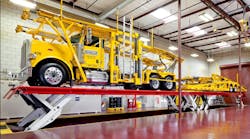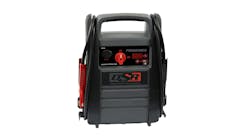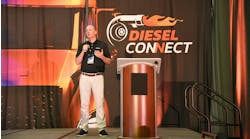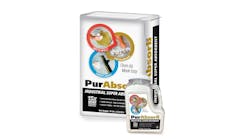With supply chain disruptions approaching their worst levels in nearly 50 years, combined with escalating business and consumer demand for product deliveries and passenger transport, a new industry overview from heavy-duty vehicle lift provider Stertil-Koni recommends a six-step approach to help large truck and bus operators maximize vehicle up time.
The stakes have never been higher—and some quick math shows why. According to Work Truck Magazine, the average cost of unscheduled commercial vehicle downtime can approach $760 per vehicle each day. And, assuming 10% of the nearly 12.5 million commercial large trucks and buses registered in the U.S. need repair on any given day, vehicle down time can conservatively cost $950 million per day.
“That’s why the proper selection and ongoing maintenance of vehicle lifts—which help service these vehicles—is particularly critical in this business climate,” said Dr. Jean DellAmore, president of Stertil-Koni. “After all, for vehicle maintenance shops across North America that already operate on tight schedules, the requirement to keep preventative maintenance and repairs on-time is essential.”
It is also why Stertil-Koni is recommending a six-step approach to ensure optimal technician safety combined with top vehicle performance.
See also: Fleet Maintenance Vehicle Lift Guide 2021
Here’s the plan, according to Stertil-Koni:
- Certification is key: Consider purchasing lifts certified by the industry’s independent, third-party watchdog—the Automotive Lift Institute (ALI). The ALI Lift Certification Program is the only accredited program in North America to independently test and validate that a vehicle meets all ANSI/ALI ALCTV (current edition) safety and performance requirements.
- Lift selection: Vehicle weight and height matter. That is why facility maintenance workers should know in advance the weight of the heaviest vehicle they intend to lift and make certain that the lift selected is certified to meet or exceed that capacity. As for height, always measure the height clearance of the facility—prior to selecting a lifting system—to ensure ample room to raise a vehicle for servicing. Further, note the height of the tallest vehicle you intend to lift and make certain there is sufficient room to raise the vehicle to a height that permits a technician to work comfortably underneath the vehicle.
- Safety first: During lift setup, check the perimeter of the lift to confirm that nothing obstructs its path and there are no hazards in the lifting area. Lift the vehicle no more than 12” off the ground, pause, and do another sweep of the area to check that there are no impediments. Then, lift the vehicle to a proper height that allows the technician to work comfortably underneath the vehicle. Also, it is advisable to select lifts, such as those from Stertil-Koni, that include an independent mechanical locking system as standard. This feature allows the lift to be lowered into its locks at a convenient height as technicians performs their work.
- Maintain a strict maintenance schedule: Make certain that all lifts are subject to a regular program of scheduled maintenance in accordance with the manufacturer’s recommended schedule and receive an annual lift inspection by an ALI Certified Lift Inspector.
- Technology matters: Look for vehicle lifts that offer new technologies to enhance operator safety and lift performance. For example, Stertil-Koni lifts feature a full-color touch-screen control console, putting all lifting information directly at the fingertips of the busy tech on the shop floor. Stertil-Koni has also introduced a Continuous Recess system for its inground scissor-style ECOLIFT and telescopic piston DIAMONDLIFT. This technology allows the lifting bolster to recess flush to the floor while moving horizontally under even the most low-profile buses and trucks. It also facilitates lift set up, minimizes the possibility of vehicles hitting the lift upon approach, and reduces tripping hazards.
- Create a culture of safety: Promoting a positive culture of safety at the shop is essential. Service bulletins, safety messages, and continuously updating technicians’ skills are vital to a smooth-running maintenance facility. Stertil-Koni also suggests using Wireless Mobile Column Lifts and selecting shop equipment specifically designed to ensure operator safety and proper ergonomics, such as the high lift wheel dolly.
See also: Lifts raise bar for ergonomics in the shop
“While we are not going to solve the supply chain challenge overnight, vehicle maintenance facilities can help ensure that their fleets are always properly serviced and ready-to-go with support from a carefully planned, heavy-duty vehicle lifting approach,” DellAmore said. “That in turn will definitely help maximize your uptime.”



